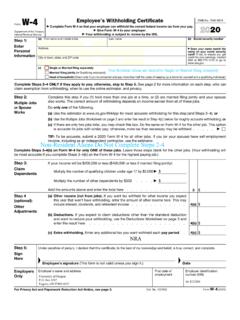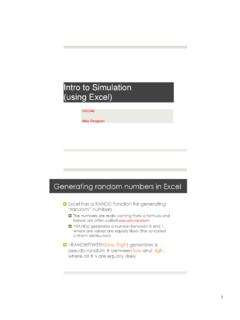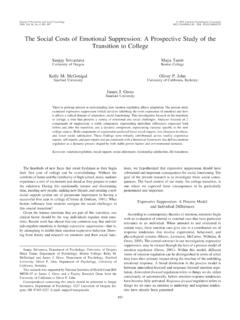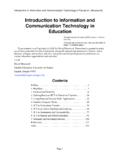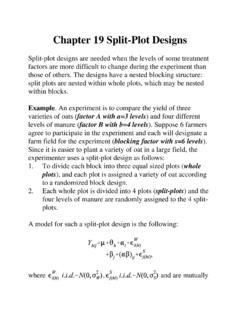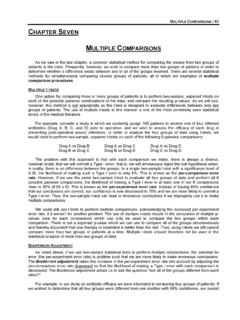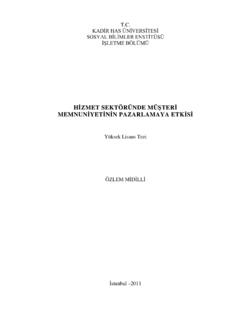Transcription of Post Hoc Tests in ANOVA
1 1 post Hoc Tests in ANOVAThis handout provides information on the use of post hoc Tests in the analysis of variance ( ANOVA ). post hoc Tests are designed for situations in which the researcher has already obtaineda significant omnibus F-test with a factor that consists of three or more means and additionalexploration of the differences among means is needed to provide specific information on whichmeans are significantly different from each example, the data file (available on the web site), contains two factors, genderand experience and one dependent measure, spatial ability score errors. Applying the GLM-Unianova procedure in SPSS produces the following ANOVA source table: Tests of Between-Subjects EffectsDependent Variable: Spatial Ability Score ErrorsSourceType IIISum ofSquaresdfMeanSquareFSig. GENDER * a R Squared =.
2 767 (Adjusted R Squared = .716)Inspection of the source table shows that both the main effects and the interaction effect aresignificant. The gender effect can be interpreted directly since there are only two levels of thefactor. Interpretation of either the Experience main effect or the Gender by Experience interactionis ambiguous, however, since there are multiple means in each effect. We will delay testing andinterpretation of the interaction effect for a later handout. The concern now is how to determinewhich of the means for the four Experience groups (see table below) are significantly differentfrom the first post hoc, the LSD test. T he original solution to this problem, developed by Fisher,was to explore all possible pair-wise comparisons of means comprising a factor using theequivalent of multiple t- Tests . This procedure was named the Least Significant Difference (LSD)test.
3 The least significant difference between two means is calculated by: _____ LSD = t o 2 MSE / n*where t is the critical, tabled value of the t-distribution with the df associated with MSE, the2denominator of the F statistic and n* is the number of scores used to calculate the means ofcriticalinterest. In our example, t at " = .05, two-tailed, with df = 32 is , MSE from thesource table above is , and n* is 10 scores per mean. _____ _____LSD = t o 2 MSE / n* = o 2 (.975 / 10 = the LSD or minimum difference between a pair of means necessary for statistical significance order to compare this critical value or difference for all our means it is useful to organize themeans in a table. First, the number of pair-wise comparisons among means can be calculated usingthe formula: k(k-1)/2, where k = the number of means or levels of the factor being tested.)
4 In ourpresent example, the experience factor has four levels so k = 4 and there are k(k-1)/2 = 4(3)/2 = 6unique pairs of means that can be with Mechanical ProblemsDependent Variable: Spatial Ability Score Errors MeanStd. Error95%ConfidenceInterval Experience Lower BoundUpper Bound A Fair Little to The table we will construct is a table showing the obtained means on the rows and columns andsubtracted differences between each pair of means in the interior cells producing a table ofabsolute mean differences to use in evaluating the post hoc Tests . To construct the table followthese steps: 1) rank the means from largest to smallest, 2) create table rows beginning with thelargest mean and going through the next-to-smallest mean, 3) create table columns starting withthe smallest mean and going through the next-to-largest mean, 4) compute the absolute differencebetween each row and column intersection/mean.
5 In the present example this results in the table ofabsolute mean differences applying our LSD value of .636 to the mean differences in the table, it can be seen that alldifferences among the means are significant at " = .05 except the last difference between the3means of and Unfortunately, the p-values associated with these multiple LSD Tests areinaccurate. Since the sampling distribution for t assumes only one t-test from any given sample,substantial alpha slippage has occurred because 6 Tests have been performed on the same true alpha level given multiple Tests or comparisons can be estimated as 1 - (1 - " ) , where cc= the total number of comparisons, contrasts, or Tests performed. In the present example 1 - (1 - " ) = 1 - (1 - .05)= .2649. Given multiple testing in this situation, the true value ofc6 alpha is approximately.
6 26 rather than . number of different solutions and corrections have been developed to deal with this problemand produce post hoc Tests that correct for multiple Tests so that a correct alpha level ismaintained even though multiple Tests or comparisons are computed. Several of these approachesare discussed s HSD test. Tukey s test was developed in reaction to the LSD test and studies haveshown the procedure accurately maintains alpha levels at their intended values as long asstatistical model assumptions are met ( , normality, homogeneity, independence). Tukey s HSDwas designed for a situation with equal sample sizes per group, but can be adapted to unequalsample sizes as well (the simplest adaptation uses the harmonic mean of n-sizes as n*). Theformula for Tukey s is: _____ HSD = q o MSE / n*where q = the relevant critical value of the studentized range statistic and n* is the number ofscores used in calculating the group means of interest.
7 Calculation of Tukey s for the presentexample produces the following: _____ _____HSD = q o MSE / n* = o .975 / 10 = q value of is obtained by reference to the studentized range statistic table looking up theq value for an alpha of .05, df = < = 32, k = p = r = 4. Thus the differences in the table of meandifferences below that are marked by the asterisks exceed the HSD critical difference and aresignificant at p < .05. Note that two differences significant with LSD are now not * * * s test. Scheffe s procedure is perhaps the most popular of the post hoc procedures, themost flexible, and the most conservative. Scheffe s procedure corrects alpha for all pair-wise orsimple comparisons of means, but also for all complex comparisons of means as well. Complexcomparisons involve contrasts of more than two means at a time.
8 As a result, Scheffe s is also the4least statistically powerful procedure. Scheffe s is presented and calculated below for our pair-wise situation for purposes of comparison and because Scheffe s is commonly applied in thissituation, but it should be recognized that Scheffe s is a poor choice of procedures unless complexcomparisons are being pair-wise comparisons, Scheffe s can be computed as follows: critical12o(k -1) F oMSE (1/n + 1/n)In our example: o(3)( ) o .975 (.1 + .1) = = referring to the table of mean differences above, it can be seen that, despite the morestringent critical difference for Scheffe s test, in this particular example, the same mean differencesare significant as found using Tukey s post hoc procedures. A number of other post hoc procedures are available.
9 There is aTukey-Kramer procedure designed for the situation in which n-sizes are not equal. Brown-Forsythe s post hoc procedure is a modification of the Scheffe test for situations withheterogeneity of variance . Duncan s Multiple Range test and the Newman-Keuls test providedifferent critical difference values for particular comparisons of means depending on how adjacentthe means are. Both Tests have been criticized for not providing sufficient protection against alphaslippage and should probably be avoided. Further information on these Tests and related issues incontrast or multiple comparison Tests is available from Kirk (1982) or Winer, Brown, and Michels(1991).Comparison of three post hoc Tests . As should be apparent from the foregoing discussion, thereare substantial differences among post hoc procedures. The procedures differ in the amount andkind of adjustment to alpha provided.
10 The impact of these differences can be seen in the table ofcritical values for the present example shown below: Critical most important issue is to choose a procedure which properly and reliably adjusts for thetypes of problems encountered in your particular research application. Although Scheffe sprocedure is the most popular due to its conservatism, it is actually wasteful of statistical powerand likely to lead to Type II errors unless complex comparisons are being made. When all pairs ofmeans are being compared, Tukey s is the procedure of choice. In special design situations, otherpost hoc procedures may also be preferable and should be explored as alternatives. Stevens, 1999

